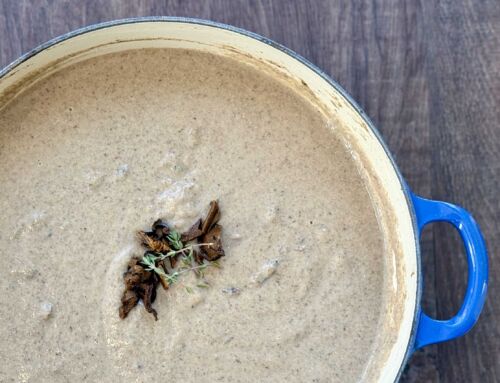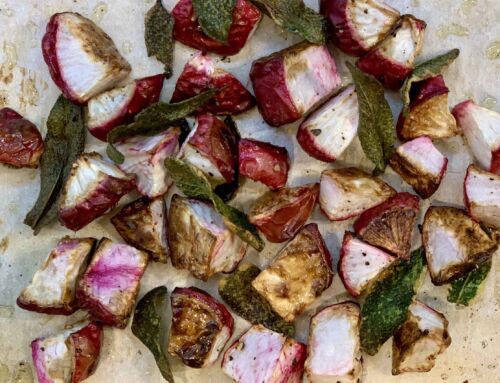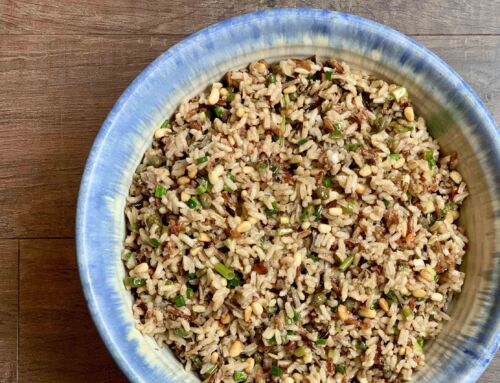It seems like the distant past, but it really was only less than six months ago. I used to leave my house and go to my office at The Institutes and have lunch in the cafeteria. Basic things that I took for granted before COVID-19.
Chef John R takes great care of my colleagues and me at The Institutes. He focuses on creative and healthy food and he makes all of his soups from scratch. One of my favorites is his pozole rojo soup made with pork, which is maybe more of a stew than soup. Where has pozole been all of my life?
 I decided that it was time to start making it at home. My first step was to have Ed make some smoked pulled pork (Boston Butt better known as pork shoulder) on the Big Green Egg. Since it takes about ten hours, he decided to make three Boston Butts, which was about 30 pounds of meat. When smoked, this yielded about 15 pounds of pork. We ate some, shared some with friends, and then froze the rest. I set aside a pound and put it in a freezer bag labeled ‘pozole pork.’
I decided that it was time to start making it at home. My first step was to have Ed make some smoked pulled pork (Boston Butt better known as pork shoulder) on the Big Green Egg. Since it takes about ten hours, he decided to make three Boston Butts, which was about 30 pounds of meat. When smoked, this yielded about 15 pounds of pork. We ate some, shared some with friends, and then froze the rest. I set aside a pound and put it in a freezer bag labeled ‘pozole pork.’
Then I started to do some research. I came across Rick Martinez’s article How to Make Pozole, Perfectly on Epicurious and used it for my inspriation. He breaks down the different colors (rojo, verde and blanco – red, green and white – the colors of Mexico’s flag) and the important ingredients. It’s a great read to get an understanding of all of the options. Despite having Chef John’s recipe for pozole rojo, I decided to go with a pozole verde this time around. I saved myself from doing a lot of math as his recipes are written to feed the masses! (Fear not, you can find my version of Chef John’s African Peanut Soup on Riegl Palate.) I liked the idea of using fresh ingredients for the ‘verde’ part during the summer.
The verde, or ‘green’, comes from the tomatillos, poblano and jalapeño peppers, and cilantro. The color, but not the taste, reminded me of pea soup. I had never cooked with tomatillos. Once husked they look like small green tomatoes (I found them in the tomato area of my grocery store). Be careful when moving the roasted tomatillos as they are fragile like cooked tomatoes.
I’d also never cooked with hominy. Pozole (or often spelled posole in the United States) is not only the name of the soup, but also the main ingredient. Pozole is called ‘hominy’ in the US and ‘mote’ in other parts of Latin America. What is it? Large soft kernels of corn often found in a can or dried. I’m a fan of dried beans but for this recipe I used canned hominy. Once you rinse and dry it on a towel, the hominy goes into the oven to dry out even more. This helps to preserve its shape in the soup. And, it also makes your kitchen smell good.
I added the smoked pulled pork to chicken stock and spices for the base. The smokiness from the pork added a great depth of flavor. Perhaps there’s a place nearby that smokes meat? You could get a pound of pulled pork from them. Your other option is to use a rotisserie chicken from the grocery store. You’ll want about a pound of chicken – preferably a combination of white and dark meat.
All of these ingredients plus a few more come together to form the most wonderfully delicious soup that gets better after it’s sits for a day or so, plus it freezes well. Assuming you have cooked meat to start, the rest of the process takes about two hours. Don’t rush it – let the flavors develop. I assure you will be pleased with the result. Thank you, Chef John, for the inspiration. I look forward to eating your creations again soon.
| Pozole Verde | Print |
- 3 15-ounce cans golden or white hominy, rinsed
- ¾ pound tomatillos, husked, rinsed
- 6 poblano peppers
- 2 jalapeño peppers
- 2 tablespoons olive oil
- 1 large yellow onion, chopped
- 6 garlic cloves, sliced
- 2 teaspoons ground coriander
- 1 teaspoon ground cumin
- 1 teaspoon dried oregano (preferably Mexican)
- 1 pound cooked and shredded pork or chicken (see Notes)
- 2 quarts chicken stock
- Kosher salt and freshly ground pepper
- 1 large bunch of cilantro, divided
- 2 tablespoons freshly squeezed lime juice
- Lime slices (for serving)
- Additional garnishes: Chopped fresh oregano, sliced avocado, sliced red onion and/or crumbled queso fresco
- Preheat oven to 425°F. Adjust shelves so two are in the middle. Cover two large baking sheets with parchment paper.
- Rinse hominy in a colander and dry on a large dish towel. Place hominy in a single layer on the one baking sheet. On a second baking sheet place tomatillos, poblano peppers and jalapeño peppers in a single layer. Place hominy baking sheet on top rack and pepper baking sheet on bottom rack.
- Hominy takes 18 to 24 minutes to cook. Stir it halfway through cooking. It is done when it is lightly toasted, very fragrant, and just beginning to brown around the edges. Remove from oven and let cool.
- Tomatillos and peppers take 40 to 45 minutes to cook. Flip halfway through cooking. They are done when tomatillos are tender and peppers are browned and collapsing. Remove from oven and let cool.
- While hominy, tomatillos and peppers are in the oven, heat oil in a large heavy pot or Dutch oven (6 to 7 quarts) over medium heat. Cook onion and garlic, stirring occasionally, until very tender, 10 to 12 minutes. Add coriander, cumin, and oregano and cook, stirring constantly, until very fragrant, about 1 minute.
- Add pork or chicken to pot and stir to coat. Add chicken stock and stir. Bring to just a boil (uncovered) over high heat. Turn down to medium-low and let simmer (uncovered) for 60 minutes.
- Once peppers are cool enough to handle, split open and discard stems and seeds along with any skin that can be easily peeled off (it’s okay to leave some on). Purée tomatillos and peppers in a blender, Vitamix or food processor until smooth. Once pork or chicken and stock have cooked for 60 minutes, stir tomatillo and peppers purée into pot and bring to a simmer. Put blender, Vitamix or food processor aside as you’ll need it later (no need to clean it).
- Stir in hominy.
- Simmer (uncovered) and season with salt and pepper as needed, until flavors meld and broth is rich tasting, about 20 minutes.
- Cut off enough cilantro to make 3 coarsely chopped tablespoons (reserve for garnish). Trim stems (about ¼-inch) and place remaining cilantro leaves and stems into a blender, Vitamix or food processor. Add ½ cup (about two ladles full) broth from pot. Purée until smooth and very bright green, about 1 minute. Stir cilantro purée into pot. Stir in 2 tablespoons of freshly squeezed lime juice. Season with salt, if needed.
- Serve pozole in bowls with additional cilantro and lime slices. Add additional garnishes (chopped fresh oregano, sliced avocado, sliced red onion and/or crumbled queso fresco), if desired.
- Soup can be made up to 3 days in advance. (Some say it’s better made a day in advance as flavors have a chance to meld even more.) Cool and refrigerate. Reheat before serving. Soup also freezes well.
* This recipe takes about 2 hours to prepare.







I have only made posole rojo – (why is it spelled with an “s” some palces and a “z” in others?) – but can’t wait to try this.
David – I started with green – next is red! From my reading it would appear that ‘posole’ is the more American spelling? I hope you enjoy it!